Seattle’s Office of Planning and Community Development (OPCD) released draft recommendations on the University District rezone and urban design proposal in late May. The draft recommendations consist of a large breadth of changes to development regulations in the neighborhood and substantially increase development capacity. Most of the proposed changes would affect the core of the neighborhood near a future light rail station planned to open in 2021.
In May, we provided a 10,000-foot view of the key policy ideas that include changes to zoning and development regulations and the addition of incentive zoning and mandatory affordable housing requirements. In a follow-up piece, we looked closer in at the primary development regulations proposed for the new SM-U zone. And in this piece, we’ll look at how the proposal would regulate floor area and height, implement mandatory affordable housing and incentive zoning, and preserve historic and vulnerable masonry structures.
As a refresher, the rezone proposal consists of three primary buckets of zoning: Seattle Mixed-University District (SM-U), Neighborhood Commercial 2 and 3 (NC2/NC3), and Midrise (MR). Zoning types are tied to specific regulatory requirements (e.g., landscaping, setbacks, building design, and site amenities) and base and maximum building heights and floor area. The rezone proposal makes general changes to each of these zoning types, but the SM-U zone is essentially a new zone carved out the SM zoning type and has the largest number of proposed changes. Areas proposed for NC2, NC3, and MR rezones will generally be subject to existing development code requirements.
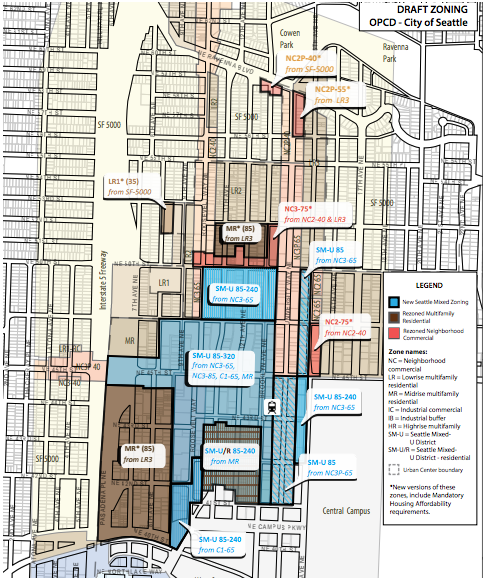
Building Height and Floor Area Ratio
Development potential on sites in the SM-U zones would be subject to two primary controls:
- Building height maximums; and
- Floor area ratio (FAR) maximums.
As you’ll note from the table below, all SM-U zones have a base maximum height of 85 feet and base FAR of 4.75. To get beyond either the base height maximum or base FAR maximum, a development would have to buy its way through incentive zoning. In the SM-U 240 zone, new development could be as tall as 240 feet (if on a site that is at least 12,000 square feet), but every square foot above 85 feet would have to be purchased through public amenities like childcare facilities and transfer of development rights (TDR). Similarly, in the SM-U 85 zone, development would typically be limited to the maximum height limit and a 4.75 FAR, but a developer could get more square footage within the box created by the 85-foot height limit using incentive zoning to buy the extra 1.25 FAR that might otherwise be left on the table.
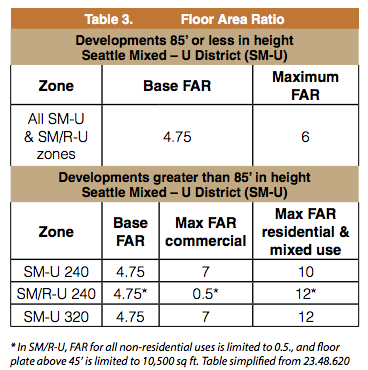
Certain uses are entirely exempt from the FAR calculation. These include any space dedicated to arts and cultural facilities, social services, schools and childcare facilities, ground floor retail and services, designated landmark structures, and specific 2+ bedroom residential unit types. So if a development proposal consisted of 100% ground floor retail across the entire site, it could be fully credited back 1.0 FAR to use for other purposes above the ground floor.
Mandatory Affordable Housing
All new development would be required to contribute toward mandatory affordable housing—know officially as “Mandatory Housing Affordability” (MHA) by the City—once the proposed rezone becomes effective. The amount of affordable housing required from new development would be based upon the amount of a particular use (i.e., residential or commercial) and whether the affordable housing is provided on-site, off-site, or through a fee in absence of performance.
- Residential development would be required to provide 5% to 8% of units1 as affordable for 50 years or provide a fee in lieu payment ranging from $7 to $12 per square foot1 based upon the gross floor area for residential use.
- Commercial development would be required to provide affordable housing on-site or off-site equal to 5% to 6.8% of chargeable square footage for commercial use, although the developer could elect to pay fee in lieu. If the fee option is chosen instead, the developer would have to pay an amount ranging from $7 to $12 per square foot of chargeable commercial area. Commercial development would be exempt from affordable housing requirements if no more than 4,000 square feet of chargeable commercial were developed on a site.
OPCD estimates that the proposed University District rezone and affordable housing program would generate somewhere between 439 and 745 affordable housing units over the next 20 years, making that a fairly hefty chunk of the new housing stock.
Incentive Zoning
Developers who seek to go beyond the base zoning and floor area allowed in the SM zones would have to provide public amenities through incentive zoning. To qualify for the additional development allowances unlocked through incentive zoning, a development proposal would have to achieve three basic standards in addition to providing specific public amenities:
- Meet the high sustainability building standards of LEED Gold certification;
- Develop a comprehensive Transportation Demand Management Plan to reduce single-occupant vehicle trips (40% or fewer) for non-residential development; and
- Provide mandatory affordable housing for the entire square footage of the development, including the bonus incentive zoning square footage.
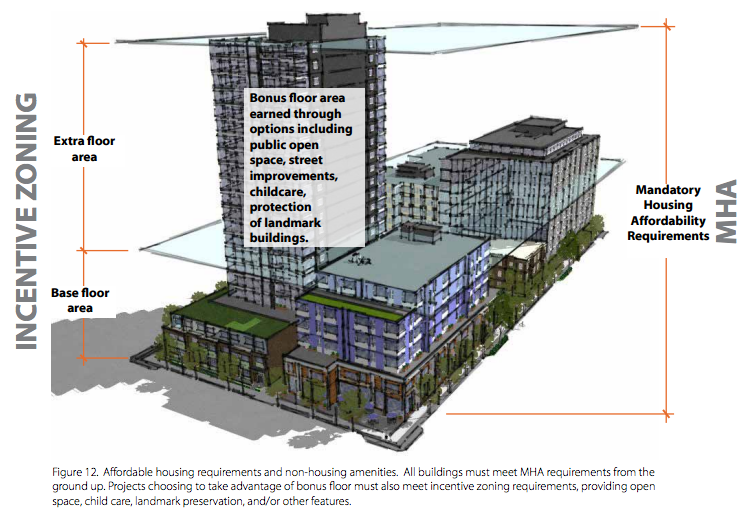
All developments would have to provide 35% of the bonus square footage through the provision of open space amenities or acquisition of TDR from open space, landmark buildings, or vulnerable masonry structures. Open space amenities include:
- Acquisition or creation of neighborhood open space. Neighborhood open space could be developed as a plaza within the development and open to the public. Or, the developer could help acquire public open space directly or through monetary contributions.
- Development of Green Street improvements planned in the neighborhood. A developer could help construct elements of the University District’s Green Street concept through new sidewalks, planter strips, landscaping, bike lanes, and street furniture.
- Providing the desired setbacks on designated Green Streets. Development on certain streets is required to provide open and landscaping adjacent to designated Green Streets.
- Developing mid-block corridors. Many developments may be able to voluntarily provide mid-block corridors (although some would be required) to create more permeability in the neighborhood. Pedestrians face very long blocks today, but more east-west options could help them navigate the University District easier.
Each of these public amenity types come with specific floor area bonus ratios. For instance, Green Street improvements garner five square feet of bonus floor area for every one square foot of Green Street improvements (5:1) while mid-block corridors garner seven square feet of bonus floor area for every one square foot of mid-block corridor space (7:1).
Developers won’t be constrained to just one public amenity option. Instead, a development could mix and match the public amenities to get to the magic 35% minimum. Some developments, if exclusively residential, may choose to acquire 100% of the bonus square footage through these options.
However, non-residential development would have to provide 65% of the bonus square footage through childcare facilities (provided on-site, off-site, or through a fee in lieu). That’s because the City has had a long-standing requirement to help provide easy access to childcare for employees in major commercial areas. Childcare facilities would have to meet very specific quality standards and provide 20% of the total number of childcare slots to those with household incomes at or below 80% of the area median income. Bonus square footage would be assessed at a ratio of one square foot for every 0.000127 of a childcare slot or a cash payment of about $4.45 per square foot.
Historic Preservation, Vulnerable Masonry Buildings, and Transfer of Development Rights
OPCD is pursuing incentives to preserve designated historic landmark buildings and vulnerable masonry buildings. Known as “transfer of development right” (TDR), property owners of historic structures or vulnerable masonry buildings would be able to sell their development rights to other developers who want to build above the base zoning or floor area ratio in the University District (TDR is one of the incentive zoning options, as discussed above). Money derived from the sale of TDRs allows property owners with older buildings to reinvest capital into rehabilitation and restoration work. These older buildings typically embody some of the best aspects of the University District’s neighborhood character and rent at more affordable rates for commercial and residential space.
Historic structures would qualify for the TDR program if they are currently registered on the City’s historic register. New landmarks could also qualify if newly designated by the Landmarks Preservation Board. Generally, a structure has to meet specific standards for historic significance or architectural character in order to be registered as a landmark. Registered landmark buildings typically have unique restrictions placed on the property that governs further development and modification, but they also receive special tax benefits in return. The University District only has seven registered landmark structures to date in the rezone area.
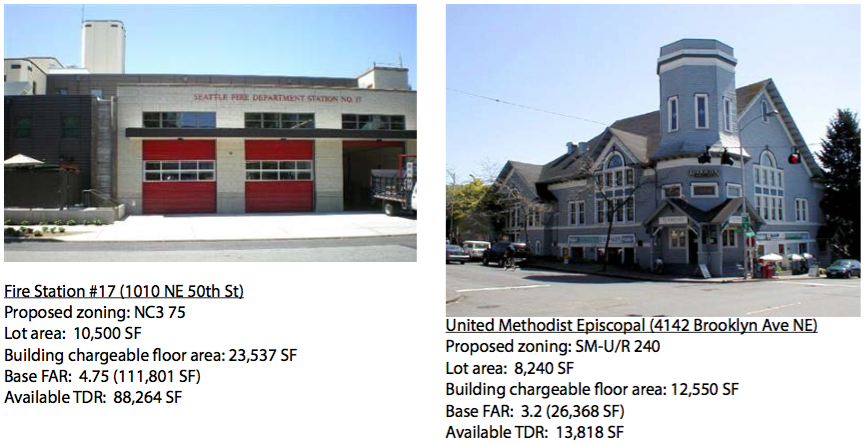
Vulnerable masonry buildings are structures that have been identified as high risk for earthquake damage. OPCD has recommended inclusion of these structures in the TDR program in order to help fund desperately needed structural retrofits. Buildings that have been identified with a designation of “Inventory” or “Hold” in the History Resource Inventory Category in the following list qualify for the TDR program. Those designated as “Hold” may also be candidates for listing on the historic register. It’s also important to note that the list of vulnerable masonry buildings may not be exhaustive; additional structures in the neighborhood may also qualify for inclusion but haven’t yet been identified.
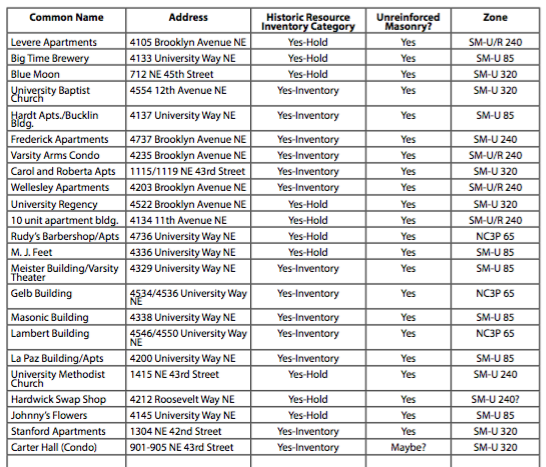
Essentially all properties zoned SM-U or NC3/NC3P may qualify as TDR sending sites (where development rights are being sent from) if there is an eligible vulnerable masonry building or designated landmark structure located on the site. Properties in the SM-U zone may also send development rights from certain types of open spaces. The amount of TDR floor area that can be sent from a particular site is limited to the amount of floor area from an existing eligible structure or open space and up to a total maximum of the base FAR that the site is entitled to. TDRs sent from NC3/NC3P and SM-U sites may only be used on eligible receiving sites zoned as SM-U within the University District. Since the TDR program is specifically designed for the neighborhood, all TDRs created there stay there; they can’t be transferred outstide of the community.
An alternative carrot for historic preservation is FAR bonuses and exemptions. On sites zoned SM-U with a designated landmark structure, developers could receive an FAR bonus of up to 0.5 FAR over the base zoning if they retain the landmark structure and rehabilitate it and exclude the historic structure floor area from the maximum FAR calculations. The 0.5 FAR bonus is the maximum permitted, but the actual bonus would be based upon the square footage of the historic structure. So if the square footage of the landmark would only equate to 0.3 FAR of the site, then that is the maximum FAR bonus that the development could attain. However, projects that seek the FAR bonus cannot double dip with TDR. If a project goes the FAR bonus route, then the developer would have to forego TDR for sending and receiving.
Conclusion
As you can glean from this in-depth discussion, the proposal has been developed so as to integrate citywide affordable housing requirements, grant greater base development rights, offer incentives for additional development rights in exchange for public amenities or desired uses, and retain valuable and vulnerable historic resources in the neighborhood. The merits of these individual policies should speak for themselves.
Admittedly, there’s much, much more to the proposal, but in our three–part series, we’ve covered the most prominent aspects of the zoning and urban design proposal for the University District. Land use wonks who want to learn more about what’s baked into the proposal would do well to read through the full draft ordinance or shorter Director’s Report. The proposal itself is still open for public review and comment through June 30th. Feedback offered to OPCD staff will be considered before final legislation is drafted and transmitted to the City Council this fall for further consideration.
The City is taking public comment on the draft recommendations through June 30th. You can submit any feedback that you may have to udistrict@seattle.gov.
Footnotes
- The actual amounts for residential have yet to be settled by legislation in the hands of the City Council. ^
Stephen is a professional urban planner in Puget Sound with a passion for sustainable, livable, and diverse cities. He is especially interested in how policies, regulations, and programs can promote positive outcomes for communities. With stints in great cities like Bellingham and Cork, Stephen currently lives in Seattle. He primarily covers land use and transportation issues and has been with The Urbanist since 2014.



